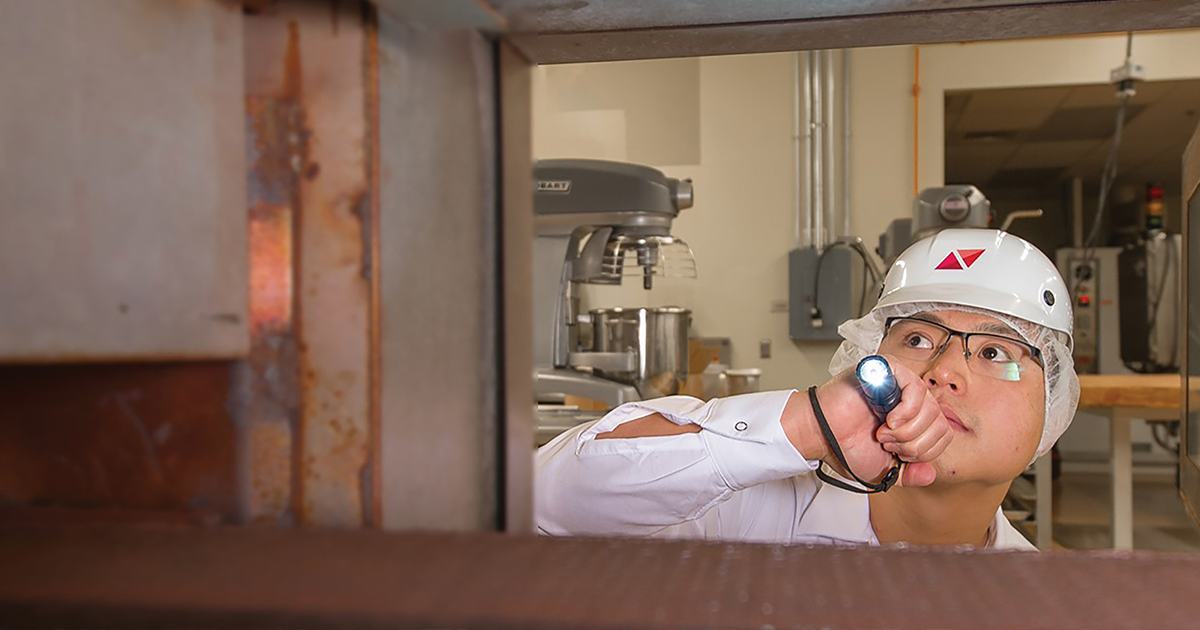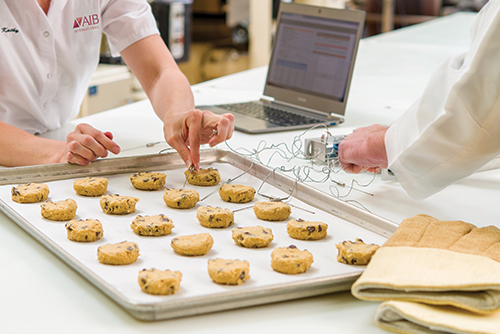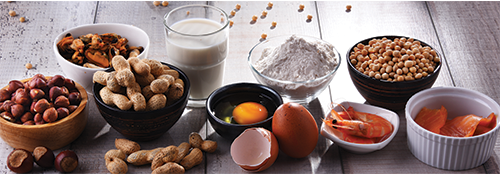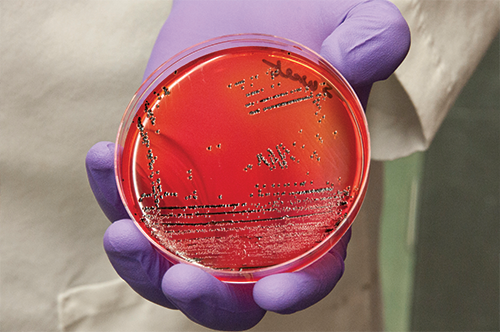Food and Drugs Act and Meat Inspection Act are signed into law.
By Charlotte Atchley
September 2021
Food safety's
new age
With new tools and best practices, the baking industry prepares to take food safety into the digital age.


AIB International
Food safety is a concern as old as food itself. In the United States, laws regarding food safety reach back more than 100 years. In 1906, the original Food and Drugs Act as well as the Meat Inspection Act were passed by Congress.
Food safety regulations have evolved to reflect changing times, but major themes have remained the same: understanding the safety and nutrition of ingredients, preventing the adulteration of food, ensuring truthful communication to consumers, controlling allergens and foreign materials, and keeping food manufacturing facilities clean. All to keep the US food supply as safe as possible.
“We have the safest food supply in the world in the US at the most affordable cost,” said Joe Stout, founder and general manager of Commercial Food Sanitation LLC. “I think it’s a precious gift and industry that we have.”
While many of the themes of food safety have remained the same, new challenges have emerged. And to maintain the gift of a safe food supply, food safety practices must evolve to keep up. In the past 10 years, with the passage of the Food Safety Modernization Act (FSMA), the industry has seen a complete overhaul of the country’s approach to food safety. While the goal may be the same, the tools and approach are brand new.

Getting proactive
While there have been many landmark shifts in food safety over the past century, the most significant one recently was the passage of FSMA in 2011. From the Food and Drug Administration (FDA)’s relationship with the industry to the companies’ approaches to food safety, the importance of this law cannot be overstated.
“Nothing has positively impacted food safety in the baking industry like FSMA” said Judi Lazaro, senior category director, food safety, AIB International. “The impact has been tremendous. Even though FSMA didn’t go into effect as soon as it was signed into law, in a way it did because consumers and customers expected more from food manufacturers. … It’s the most sweeping change in 70 years.”
FSMA was passed in response to several significant food safety events shook the public’s confidence in the US food supply, most notably a 2008 salmonella outbreak traced to a Georgia factory operated by the Peanut Corp. of America. The outbreak resulted in 700 cases of salmonella poisoning and nine deaths. The former chief executive officer of the company was sentenced to 28 years in prison, the harshest sentence handed down for someone responsible for a foodborne illness outbreak.
This incident signaled to both government agencies and the food industry that a systemic shift in how the industry approached food safety was needed. Rather than reacting to incidents, the food industry needed to be more proactive in preventing them. FSMA was designed to provide guidance and tools to ensure that happened.
“FSMA was the catalyst for the change, the enhancements, the additions,” explained Lee Sanders, senior vice president, government relations and public affairs, American Bakers Association (ABA). “FDA changed their inspection focus from a snapshot-in-time to a system that is always in place. That’s a completely different approach.”
For the first time, the FDA could require comprehensive, science-based preventive controls that included requiring food manufacturers to document and implement these plans. Inspections, testing and records access were new tools FSMA put in the hands of the FDA to ensure oversight, and FDA was given the ability to issue mandatory recalls in the event a company fails to do so voluntarily. Manufacturers faced other consequences as well, such as administrative detention for products potentially in violation of the law, suspension of facility registration, enhanced product tracing and additional record-keeping requirements for high-risk foods.
Ms. Sanders explained the new approach: “What systems do you have in place to ensure that your product is always safe, that you have the right staff trained for those critical jobs and that protocols are always being followed so that you’re confident in the product that leaves the production facility?”
FSMA also gave the FDA authority to hold imported food to the same standard as domestic products and encouraged the agency to bolster its partnerships with other federal agencies and those at the state and local level. While the food industry experienced a culture shift as it implemented FSMA, FDA’s new focus on partnership required a similar shift in the agency as well.
“I think there’s been a concerted effort for FDA to be more open,” Ms. Sanders said of FSMA guidance. “While the nutrition staff at FDA was more accustomed to working with the industry, the food safety staff took more of a compliance approach. The FDA realized it needed to change that culture. … The agency has been open to listening and partnering with us, and having framework in place where we could do that as the whole food industry was critical.”
She’s referring to the Food and Beverage Issue Alliance (FBIA), which is a broad coalition of more than 50 US-based food and beverage trade associations that communicate regularly with federal agencies like FDA and the US Department of Agriculture regarding regulations and guidance.
“Early on as the FSMA rules came together, we saw the need to bring the food industry together as a whole to dialogue with the FDA to share the challenges we’re seeing and provide an opportunity to weigh in and share information,” said Rasma Zvaners, vice president, regulatory and technical services, ABA. “We may not always agree, but we’re more proactive getting in front of issues and asking questions. I look back, and if we hadn’t had that proactive conversation and structure in place, we wouldn’t have been able to be as nimble in responding to COVID-19 because we knew how to engage with the agency and have an open dialogue.”
When it comes to the details of FSMA — and there are many — a few themes emerged that have completely revamped the way the food industry, including the baking sector, thinks about food safety programs. One of the most significant is the emphasis on having preventative controls and documentation that the company is implementing those controls effectively. This forces companies to be proactive and significantly raises accountability, as well as the number of audits and inspections.
“FSMA made all companies of all sizes think about their food safety plans, their company’s internal workings and their team’s approach to food safety day-by-day,” Ms. Sanders said. “There are a lot of audits and inspections now, and bakers have to know how to manage those and make sure they’re covering those critical points. Being able to demonstrate to customers that they are doing the right thing every day has been a big driver in all of this.”
Audits and inspections aren’t new to the baking industry. Before FSMA, the industry largely followed standards set forth by the Global Food Safety Initiative (GFSI) and were audited by a third party to confirm those standards were being met.
“I don’t think the baking industry was shocked by what was coming from FSMA,” Ms. Lazaro said. “They were surprised by the regulatory action that FDA would now show up and hold them accountable. The industry was previously used to only being held accountable by customers and consumers.”
In addition to GFSI audits, bakeries today undergo audits by individual customers as well as FDA inspections and, in many instances, AIB International inspections. The focus has changed too, Ms. Lazaro — who once was an inspector — pointed out.
“Now you can’t do business without an independent inspection,” she said. “And they have greatly evolved. When I was a food safety inspector, that meant 75%-80% of my time was on the production floor inspection, and 20% was spent looking at records and programs. Now we focus more on the programs and records and some time on the floor.”
Ms. Lazaro warns, however, that this emphasis on inspections and audits could backfire.
“I do think there comes a time where we have an audit overload that we are so worried about the audit that we lose sight of what we’re preparing for, which should be prioritizing food safety,” she said.
The other piece of FSMA that will come into play next is the focus on modernization and using the technology of today to take food safety to the next level.
“The FDA is looking at smarter food safety through its Smarter Food Safety initiative,” Mr. Stout said. “In the age of iPhones, iPads and other computerization, it seems to me that we should be able to have a much brighter and connected food safety program in manufacturing plants. That includes pre-op inspections, recording them, tracking them. The technology has really helped us out on monitoring critical control points. You can see the information live on your desktop and know exactly what’s going on; lab results come in automatically, and all of this saves us time and money and helps us be more efficient.”

Food and Drugs Act and Meat Inspection Act are signed into law.
First Certified Color Regulations list seven colors suitable for food.
In US vs. Lexington Mill and Elevator Co., the Supreme Court bans bleached flour with nitrite residue.
The Federal Food, Drug and Cosmetic Act is passed by Congress, authorizing factory inspections, standards of identity and safe tolerances for unavoidable poisonous substances.
In US vs. Dotterweich, Supreme Court rules responsible officials of a corporation can be prosecuted for violations.
FDA publishes its first guidance to the industry, “Procedures for the Appraisal of the Toxicity of Chemicals in Food.”
FDA publishes the first list of GRAS substances.
Color Additive Amendment requires manufacturers to establish the safety of color additives.
President John F. Kennedy proclaims the Consumer Bill of Rights, including the right to safety, to be informed, the right to choose and the right to be heard.
Saccharin is banned from GRAS list.
FDA publishes “Toxicological Principles for the Safety Assessment of Direct Food Additives and Color Additives Used in Food.”
Nutrition Labeling and Education Act requires all packaged food to have nutrition labeling and health claims consistent with terms defined by the Secretary of Health and Human Services.
Food Allergy Labeling and Consumer Protection Act is passed, requiring labeling of any food that contains a protein from peanuts, soybeans, cow’s milk, eggs, fish, crustacean shellfish, tree nuts and wheat.
Food Safety Modernization Act is passed.
Sesame is added to the list of major allergens.
You might also enjoy:
Overcoming obstacles and chasing innovation, the pet food industry prepares for its promising future.
Today’s meat and poultry processors carefully manage expectations to feed people, preserve the planet and deliver profits in the future.
Challenges for the future
Building off the foundation laid by FSMA, the FDA announced its blueprint for the New Era of Smarter Food Safety in July 2020. This blueprint — a PDF document that bakers can find on FDA’s website — outlines FDA’s approach to food safety going forward. It leans heavily on the processes put in place by FSMA but also focuses on four core elements: tech-enabled traceability, smarter tools and approaches for prevention and outbreak response, new business models and retail modernization, and food safety culture.
“The New Era of Smarter Food Safety is an approach to bending the curve of foodborne illness through the use of new technologies and approaches,” said Frank Yiannas, deputy FDA commissioner.
This new era is ushered in by the final rule of FSMA that needs to be implemented. The Traceability Rule, currently under review, digitizes traceability and provides transparency across the supply chain.
Companies that manufacture, process, pack or hold food on the Food Traceability List will capture required data points, store them electronically or in paper records for 24 months. Companies must also share key data elements with other partners in the supply chain.
“The vision for the FDA is that trading partners would be able to speak the same language through the standardization of what they are calling critical tracking events and key data elements,” said Julie McGill of FoodLogicQ during an educational session at the American Society of Baking’s technical conference earlier this year. “Tech-enabled traceability will enable companies to meet the expectations of this new era of smarter food safety and eventually get to the place where interoperability is within those systems.”
While previous FSMA rules have left room for different industries to adapt their existing processes, this proposed rule will call for industry to conform to FDA.
“FDA has been good about setting broad parameters, and individual food sectors can tweak their best practices to fit regulations, rather than FDA being overly prescriptive,” Ms. Zvaners said. “We support food safety, but we strongly encourage FDA to keep it simple. We feel that some of this may be overly prescriptive.”
While the public comments are closed for this rule, the FDA has not issued a final rule, but has until November 2022 to do so.
FDA’s blueprint also will explore using technology and data in prevention and outbreak response, but also promoting safety in new business models like e-commerce and the expanding market for food delivery. These accelerated markets pose new challenges for the safe handling of food. Some of these business models were new or nonexistent when FSMA was signed into law, and therefore aren’t adequately addressed.
While most of the baking industry uses a kill step such as the oven or fryer to control pathogens, that fatal peanut butter tragedy of 2008 has everyone re-thinking pathogens and what high-risk really means.
“Peanut butter wasn’t considered a high-risk food before that because it is a low water activity product,” said Meaghan Meyer, senior vice president of food safety and quality for Indianapolis-based CraftMark Bakery and co-chair for ABA’s food technical regulatory affairs professional group. “But science is showing us that pathogens survive in low water activity products, and there is a significant concern of post-kill step contamination of products with pathogens. This contamination can happen from contaminated raw material added after the kill step or post-kill step contamination from an environmental factor in the bakery.”
The increasingly complex global supply chain will also be under the microscope of food safety moving forward. This has become even more important considering the recent challenges the supply chain has experienced.
“The supply chain is more complicated than ever before as we source raw materials from multiple suppliers across all parts of the world,” Ms. Meyer said. “Ensuring that we have a safe, consistent supply is more important than it has ever been.”
As bakers and other food manufacturers continue to endure workforce challenges, work safety culture, the fourth pillar of the blueprint, will become even more critical. All the protocols and procedures can be in place, but without a culture of food safety, they will not be effective.
“The baking industry is feeling the pinch of tight employment resources,” Ms. Meyer said. “The shortage of workers is hitting us hard and causing increased turnover, and bakers are turning to temp workers to fill that gap. That leads to the need for additional training and resources to make sure that no mistakes are made.”
While FDA plans to work on best practices going forward, GFSI published its “A Culture of Food Safety” paper in 2018, which provides broad guidelines on establishing and fostering a culture of food safety. Buy-in at every level of the company is key as culture is a top-down initiative. Communication of expectations and follow-through are other key points to developing a workplace culture.
CraftMark’s top leaders are involved in the food safety teams, and every member of the bakery team must attend food safety culture training to understand the company’s priorities.
“It ultimately is ensuring that our actions match our words,” Ms. Meyer said. “Engaging employees at all levels of the organization to understand why food safety is critical to success and then reinforcing that through conversations and training.”
CraftMark follows this up with not only audits but also employee surveys to get feedback on their perception of our food safety culture.
“Do they feel like they’re listened to? Are they asked to compromise on food safety?” Ms. Meyer said, giving examples. “This is just one of the outlets we give our employees to report back to us.”
Another key part of food safety is the sanitation team, and a culture that prioritizes food safety will be critical to keeping employees on this team.
“How do you motivate the sanitation team and help them feel good about what they do because you can’t replace the sanitation team,” Mr. Stout said. “You can automate mixing, slicing, packaging, but it’s really hard to automate sanitation. So the question is how do we get those people in place and motivated to do their jobs well.”
A culture that prioritizes food safety will also prioritize sanitation and show the team that their work is valued. Mr. Stout also recommended bakers take on an attitude of smart sanitation: that is sanitation is the responsibility of everyone in the bakery, not just the sanitation team.
“We need to move closer to that, and that would be part of the cultural revolution that we need that FDA talks about in its New Era of Food Safety,” he said.
All of this comes back to training, communication and accountability, which will become pivotal as bakers bring on new employees — many of whom have never worked in food manufacturing — and move forward into this new frontier of proactive food safety.
“I don’t think anyone goes to work not to do a good job, and that is true of food safety,” Ms. Lazaro said. “Mistakes happen because people aren’t trained properly or held accountable. With the increasingly inexperienced workforce, I hope the entire industry pays attention to education.”
The future of food safety may be leaning on high-tech digital tools, but it will be rooted in the things that keep bakeries running smoothly: efficient processes, well-communicated protocols and effective training.

